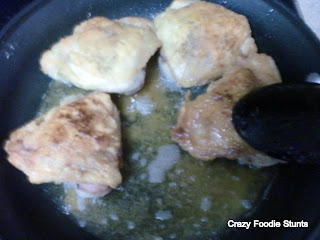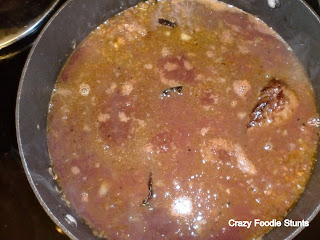 |
| Pollo alla Cacciatore con Polenta |

Since I published the dessert course of a dinner party I hosted earlier this week, I thought I'd also profile the entreé course. I also wanted to do so to show my appreciation to Kaitlin of
I Can Cook That because I used recipes from the cookbook I won in her giveaway. I've prepared Michael Chiarello's
chicken cacciatore recipe and his
polenta recipe in the past, but have since learned Chef Chiarello uses some non-traditional ingredients and wanted to update it.
I also love that Chef Bastianich uses yellow corn meal in her polenta. I've used the stuff that is labeled 'polenta' at the grocery store but struggled to find a significant difference. At almost twice the price it was difficult to justify. Her method is also slightly altered from others I've seen.
The Challenge
Update a dish I profiled earlier with more authentic ingredients.
The Source
Adapted from pages 152 to 153 and 91 to 92 of
Lidia's Favorite Recipes by Lidia Matticchio Bastianich and Tanya Bastianich Manuali.
Ingredients
8 skin-on bone-in chicken thighs
kosher salt and freshly ground black pepper
all-purpose flour
1/4 cup vegetable oil
1/4 cup plus 1 tablespoon extra-virgin olive oil, divided
1 small yellow onion, chopped
1/2 cup dry white wine
1 28-ounce can crushed tomatoes
1 tablespoon fresh oregano, minced
8 ounces fresh white mushrooms, sliced
1 red bell pepper, cored, seeded and cut into 1/2-inch strips
1 yellow bell pepper, cored, seeded and cut into 1/2-inch strips
8 cups water, divided
2 bay leaves
1 tablespoon kosher salt, or as needed
1 1/2 cups yellow corn meal
1 tablespoon fresh Italian parsley, chopped fine (for garnish)
Method
1. Season the chicken with kosher salt and freshly ground black pepper. Dredge the chicken in the flour coating them lightly. Heat th vegetable oil in a wide pan with 2 tablespoons of the olive oil and add the chicken to brown. Cook in batches if all of the chicken doesn't fit into the pan at once. Once browned, remove from pan onto a plate.
2. Add the onion to the fat in the pan, stirring for 5 minutes. Deglaze the pan with the white wine and bring to a boil, cooking until reduced by half, about 3 minutes. Add the tomatoes and oregano, lightly seasoning the fluid with salt and pepper. Add the chicken back to the pan, reducing to a simmer, cover and cook for 20 minutes.
3. While the chicken simmers, heat the remaining 2 tablespoons in a skillet over medium-high heat. Add the mushrooms and peppers, tossing until the peppers are wilted but still crisp, seasoning with salt, about 8 minutes.
4. Add the vegetables to the chicken, cover and cook until the vegetables are tender, about 10 to 15 minutes, adding water to barely cover the chicken along the way if necessary.
5. While the vegetables sauté, bring 4 cups of water to a simmer in a small saucepan. Cover and keep warm over medium-low heat. Combine the remaining water, bay leaves and 1 tablespoon salt to a boil in a 3- to 4-quart saucepan over medium-high heat. When boiling, add the olive oil.
6. Slowly add the corn meal to the larger saucepan a little at a time, stirring continuously with a wooden spoon or spatula. This should take approximately 5 minutes. Once all the corn meal has been added, the mixture should be thick, with large bubbles popping on the surface. Reduce heat to medium-low and continue stirring until it becomes so thick that your spoon cannot move easily, about 4 minutes.
7. Add 1 cup of the reserved water to restore the mixture to a smoother consistency and continue stirring until thick. Repeat this process (adding water to loosen and then stirring until thick) until the corn meal is tender, about 20 minutes. Continue stirring weithout the water additions until the corn meal is shiny and it is thick enough to stand a spoon in it. To serve, spoon some polenta on a plate, adding the braising fluid, then topping with the chicken. Garnish with parsley.
Successful?
I kept the polenta a little looser than the recipe suggests so I could present it differently. Most other recipes I've seen combined 1 part polenta with 4 parts liquid, then stirring continuously until thick, so Chef Bastianich alters this process slightly.
Ultimately, the extra effort was worth it as I enjoyed the flavors, but more importantly, my guests did too.
































